Jiashu Pu
New Recipe for Semi-supervised Community Detection: Clique Annealing under Crystallization Kinetics
Apr 22, 2025Abstract:Semi-supervised community detection methods are widely used for identifying specific communities due to the label scarcity. Existing semi-supervised community detection methods typically involve two learning stages learning in both initial identification and subsequent adjustment, which often starts from an unreasonable community core candidate. Moreover, these methods encounter scalability issues because they depend on reinforcement learning and generative adversarial networks, leading to higher computational costs and restricting the selection of candidates. To address these limitations, we draw a parallel between crystallization kinetics and community detection to integrate the spontaneity of the annealing process into community detection. Specifically, we liken community detection to identifying a crystal subgrain (core) that expands into a complete grain (community) through a process similar to annealing. Based on this finding, we propose CLique ANNealing (CLANN), which applies kinetics concepts to community detection by integrating these principles into the optimization process to strengthen the consistency of the community core. Subsequently, a learning-free Transitive Annealer was employed to refine the first-stage candidates by merging neighboring cliques and repositioning the community core, enabling a spontaneous growth process that enhances scalability. Extensive experiments on \textbf{43} different network settings demonstrate that CLANN outperforms state-of-the-art methods across multiple real-world datasets, showcasing its exceptional efficacy and efficiency in community detection.
LANID: LLM-assisted New Intent Discovery
Mar 31, 2025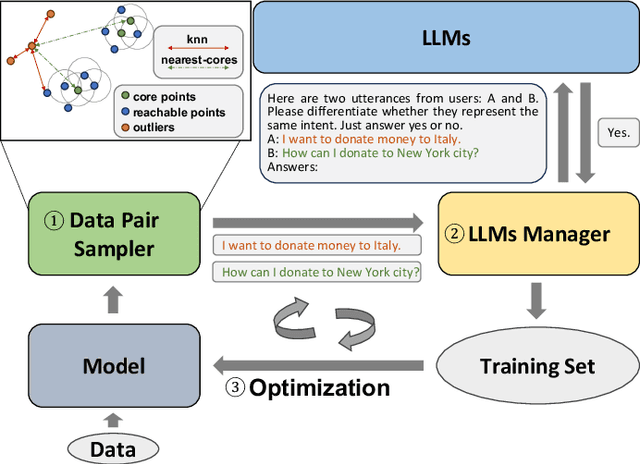


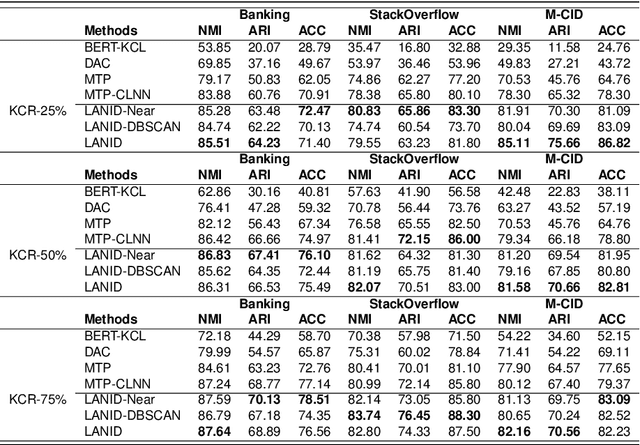
Abstract:Task-oriented Dialogue Systems (TODS) often face the challenge of encountering new intents. New Intent Discovery (NID) is a crucial task that aims to identify these novel intents while maintaining the capability to recognize existing ones. Previous efforts to adapt TODS to new intents have struggled with inadequate semantic representation or have depended on external knowledge, which is often not scalable or flexible. Recently, Large Language Models (LLMs) have demonstrated strong zero-shot capabilities; however, their scale can be impractical for real-world applications that involve extensive queries. To address the limitations of existing NID methods by leveraging LLMs, we propose LANID, a framework that enhances the semantic representation of lightweight NID encoders with the guidance of LLMs. Specifically, LANID employs the $K$-nearest neighbors and Density-Based Spatial Clustering of Applications with Noise (DBSCAN) algorithms to sample selective utterance pairs from the training set. It then queries an LLM to ascertain the relationships between these pairs. The data produced from this process is utilized to design a contrastive fine-tuning task, which is then used to train a small encoder with a contrastive triplet loss. Our experimental results demonstrate the efficacy of the proposed method across three distinct NID datasets, surpassing strong baselines in both unsupervised and semi-supervised settings. Our code is available at https://github.com/floatSDSDS/LANID.
HoLLMwood: Unleashing the Creativity of Large Language Models in Screenwriting via Role Playing
Jun 17, 2024Abstract:Generative AI has demonstrated unprecedented creativity in the field of computer vision, yet such phenomena have not been observed in natural language processing. In particular, large language models (LLMs) can hardly produce written works at the level of human experts due to the extremely high complexity of literature writing. In this paper, we present HoLLMwood, an automated framework for unleashing the creativity of LLMs and exploring their potential in screenwriting, which is a highly demanding task. Mimicking the human creative process, we assign LLMs to different roles involved in the real-world scenario. In addition to the common practice of treating LLMs as ${Writer}$, we also apply LLMs as ${Editor}$, who is responsible for providing feedback and revision advice to ${Writer}$. Besides, to enrich the characters and deepen the plots, we introduce a role-playing mechanism and adopt LLMs as ${Actors}$ that can communicate and interact with each other. Evaluations on automatically generated screenplays show that HoLLMwood substantially outperforms strong baselines in terms of coherence, relevance, interestingness and overall quality.
Crafting a Good Prompt or Providing Exemplary Dialogues? A Study of In-Context Learning for Persona-based Dialogue Generation
Feb 17, 2024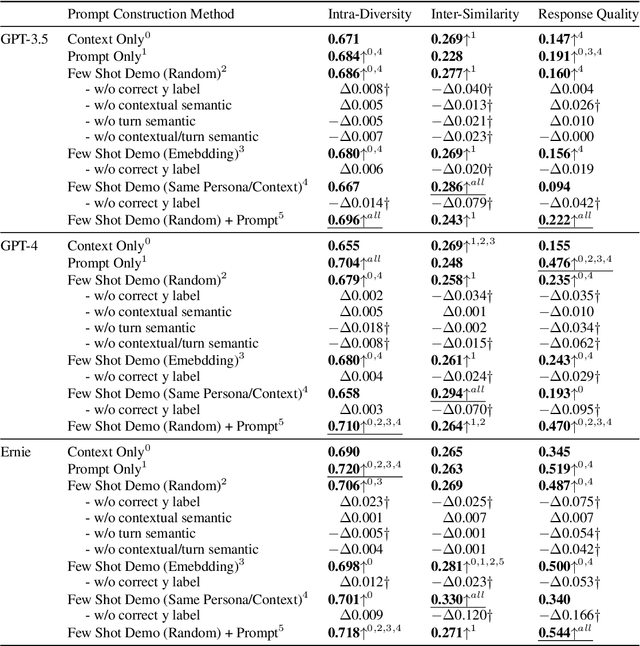
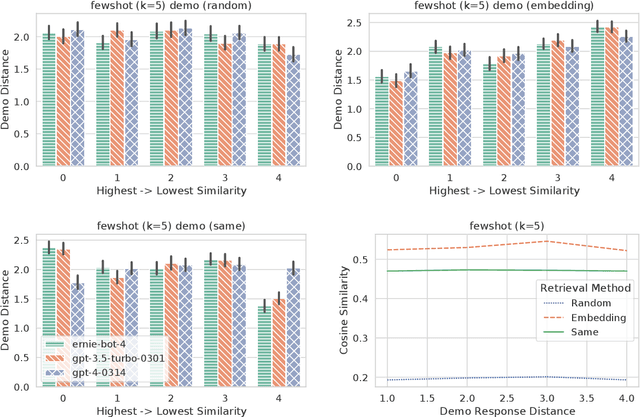
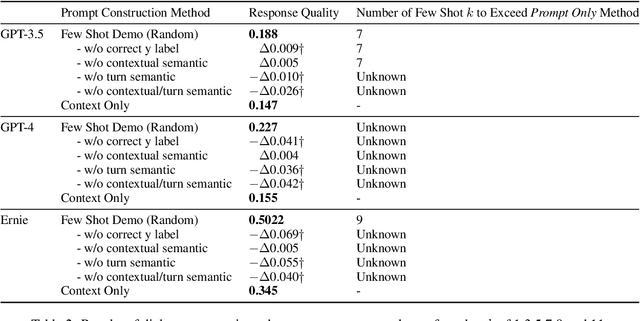
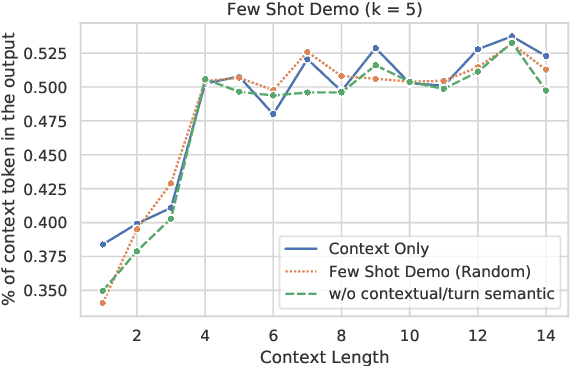
Abstract:Previous in-context learning (ICL) research has focused on tasks such as classification, machine translation, text2table, etc., while studies on whether ICL can improve human-like dialogue generation are scarce. Our work fills this gap by systematically investigating the ICL capabilities of large language models (LLMs) in persona-based dialogue generation, conducting extensive experiments on high-quality real human Chinese dialogue datasets. From experimental results, we draw three conclusions: 1) adjusting prompt instructions is the most direct, effective, and economical way to improve generation quality; 2) randomly retrieving demonstrations (demos) achieves the best results, possibly due to the greater diversity and the amount of effective information; counter-intuitively, retrieving demos with a context identical to the query performs the worst; 3) even when we destroy the multi-turn associations and single-turn semantics in the demos, increasing the number of demos still improves dialogue performance, proving that LLMs can learn from corrupted dialogue demos. Previous explanations of the ICL mechanism, such as $n$-gram induction head, cannot fully account for this phenomenon.
Examining the Effect of Pre-training on Time Series Classification
Sep 11, 2023Abstract:Although the pre-training followed by fine-tuning paradigm is used extensively in many fields, there is still some controversy surrounding the impact of pre-training on the fine-tuning process. Currently, experimental findings based on text and image data lack consensus. To delve deeper into the unsupervised pre-training followed by fine-tuning paradigm, we have extended previous research to a new modality: time series. In this study, we conducted a thorough examination of 150 classification datasets derived from the Univariate Time Series (UTS) and Multivariate Time Series (MTS) benchmarks. Our analysis reveals several key conclusions. (i) Pre-training can only help improve the optimization process for models that fit the data poorly, rather than those that fit the data well. (ii) Pre-training does not exhibit the effect of regularization when given sufficient training time. (iii) Pre-training can only speed up convergence if the model has sufficient ability to fit the data. (iv) Adding more pre-training data does not improve generalization, but it can strengthen the advantage of pre-training on the original data volume, such as faster convergence. (v) While both the pre-training task and the model structure determine the effectiveness of the paradigm on a given dataset, the model structure plays a more significant role.
Sudowoodo: a Chinese Lyric Imitation System with Source Lyrics
Aug 09, 2023Abstract:Lyrics generation is a well-known application in natural language generation research, with several previous studies focusing on generating accurate lyrics using precise control such as keywords, rhymes, etc. However, lyrics imitation, which involves writing new lyrics by imitating the style and content of the source lyrics, remains a challenging task due to the lack of a parallel corpus. In this paper, we introduce \textbf{\textit{Sudowoodo}}, a Chinese lyrics imitation system that can generate new lyrics based on the text of source lyrics. To address the issue of lacking a parallel training corpus for lyrics imitation, we propose a novel framework to construct a parallel corpus based on a keyword-based lyrics model from source lyrics. Then the pairs \textit{(new lyrics, source lyrics)} are used to train the lyrics imitation model. During the inference process, we utilize a post-processing module to filter and rank the generated lyrics, selecting the highest-quality ones. We incorporated audio information and aligned the lyrics with the audio to form the songs as a bonus. The human evaluation results show that our framework can perform better lyric imitation. Meanwhile, the \textit{Sudowoodo} system and demo video of the system is available at \href{https://Sudowoodo.apps-hp.danlu.netease.com/}{Sudowoodo} and \href{https://youtu.be/u5BBT_j1L5M}{https://youtu.be/u5BBT\_j1L5M}.
I-WAS: a Data Augmentation Method with GPT-2 for Simile Detection
Aug 08, 2023Abstract:Simile detection is a valuable task for many natural language processing (NLP)-based applications, particularly in the field of literature. However, existing research on simile detection often relies on corpora that are limited in size and do not adequately represent the full range of simile forms. To address this issue, we propose a simile data augmentation method based on \textbf{W}ord replacement And Sentence completion using the GPT-2 language model. Our iterative process called I-WAS, is designed to improve the quality of the augmented sentences. To better evaluate the performance of our method in real-world applications, we have compiled a corpus containing a more diverse set of simile forms for experimentation. Our experimental results demonstrate the effectiveness of our proposed data augmentation method for simile detection.
* 15 pages, 1 figure
Neighborhood-based Hard Negative Mining for Sequential Recommendation
Jun 12, 2023Abstract:Negative sampling plays a crucial role in training successful sequential recommendation models. Instead of merely employing random negative sample selection, numerous strategies have been proposed to mine informative negative samples to enhance training and performance. However, few of these approaches utilize structural information. In this work, we observe that as training progresses, the distributions of node-pair similarities in different groups with varying degrees of neighborhood overlap change significantly, suggesting that item pairs in distinct groups may possess different negative relationships. Motivated by this observation, we propose a Graph-based Negative sampling approach based on Neighborhood Overlap (GNNO) to exploit structural information hidden in user behaviors for negative mining. GNNO first constructs a global weighted item transition graph using training sequences. Subsequently, it mines hard negative samples based on the degree of overlap with the target item on the graph. Furthermore, GNNO employs curriculum learning to control the hardness of negative samples, progressing from easy to difficult. Extensive experiments on three Amazon benchmarks demonstrate GNNO's effectiveness in consistently enhancing the performance of various state-of-the-art models and surpassing existing negative sampling strategies. The code will be released at \url{https://github.com/floatSDSDS/GNNO}.
Probing Simile Knowledge from Pre-trained Language Models
Apr 27, 2022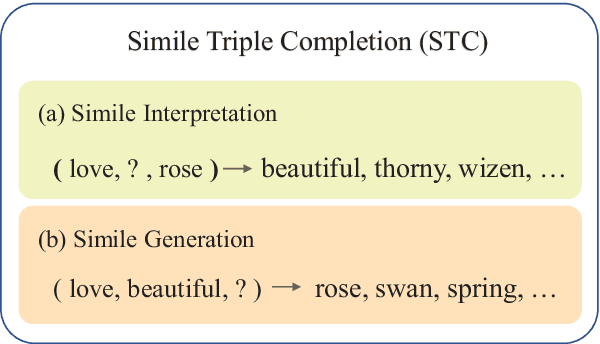
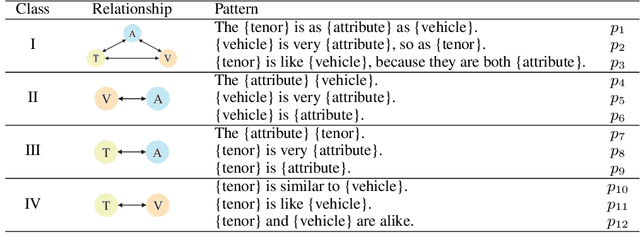
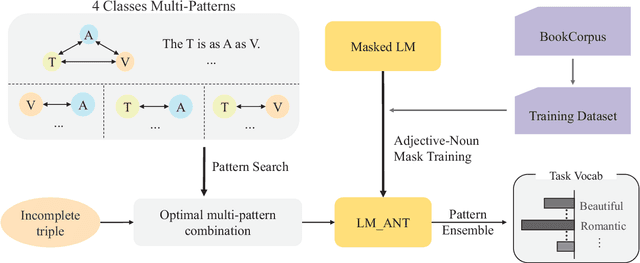
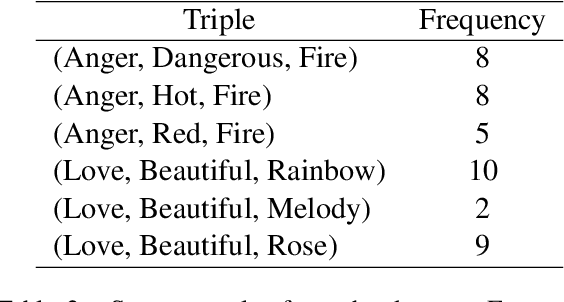
Abstract:Simile interpretation (SI) and simile generation (SG) are challenging tasks for NLP because models require adequate world knowledge to produce predictions. Previous works have employed many hand-crafted resources to bring knowledge-related into models, which is time-consuming and labor-intensive. In recent years, pre-trained language models (PLMs) based approaches have become the de-facto standard in NLP since they learn generic knowledge from a large corpus. The knowledge embedded in PLMs may be useful for SI and SG tasks. Nevertheless, there are few works to explore it. In this paper, we probe simile knowledge from PLMs to solve the SI and SG tasks in the unified framework of simile triple completion for the first time. The backbone of our framework is to construct masked sentences with manual patterns and then predict the candidate words in the masked position. In this framework, we adopt a secondary training process (Adjective-Noun mask Training) with the masked language model (MLM) loss to enhance the prediction diversity of candidate words in the masked position. Moreover, pattern ensemble (PE) and pattern search (PS) are applied to improve the quality of predicted words. Finally, automatic and human evaluations demonstrate the effectiveness of our framework in both SI and SG tasks.
Dialog Intent Induction via Density-based Deep Clustering Ensemble
Jan 18, 2022



Abstract:Existing task-oriented chatbots heavily rely on spoken language understanding (SLU) systems to determine a user's utterance's intent and other key information for fulfilling specific tasks. In real-life applications, it is crucial to occasionally induce novel dialog intents from the conversation logs to improve the user experience. In this paper, we propose the Density-based Deep Clustering Ensemble (DDCE) method for dialog intent induction. Compared to existing K-means based methods, our proposed method is more effective in dealing with real-life scenarios where a large number of outliers exist. To maximize data utilization, we jointly optimize texts' representations and the hyperparameters of the clustering algorithm. In addition, we design an outlier-aware clustering ensemble framework to handle the overfitting issue. Experimental results over seven datasets show that our proposed method significantly outperforms other state-of-the-art baselines.
 Add to Chrome
Add to Chrome Add to Firefox
Add to Firefox Add to Edge
Add to Edge